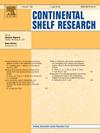Wave influence on water circulation and self-purification ability in a semi-enclosed sea
IF 2.2
3区 地球科学
Q2 OCEANOGRAPHY
引用次数: 0
Abstract
Owing to significant variation in waves, studying the effects of waves on water exchange in semi-enclosed seas is challenging, and current knowledge on this subject is insufficient, which hinders effective management of coastal seas. In this study, wave-current coupled and water age models were established to investigate the influence of waves on water exchange in the Bohai Sea, China. The results show that waves do not affect basin-scale circulation in the Bohai Sea, and their effects on water exchange are restricted to nearshore regions, especially in estuaries with subaqueous deltas. Wave-induced age variation is around 5 %, peaking at 16 % nearshore. The wave effects on basin-scale water exchange are an order of magnitude smaller than those induced by winds, yet they govern the exchange process near the Yellow River Estuary. Analysis of age distributions with and without waves indicates that wind fetch and topographic conditions are important factors in determining the wave influence on currents. Wind and storm statistics suggest that north and northeast winds are dominant. Under these conditions, the nearshore regions in the south of the Bohai Sea and downwind areas experience strong wave forces. Due to drastic depth variations at the edges of subaqueous deltas, waves induce a strong longshore current flowing westward into Laizhou Bay, with the wave influence extending nearly 100 km.
波浪对半封闭海域水循环和自净能力的影响
由于波浪的显著变化,研究波浪对半封闭海水交换的影响是具有挑战性的,目前关于这一主题的知识不足,这阻碍了对沿海海的有效管理。本文建立了波流耦合模型和水龄模型,探讨了波浪对渤海水体交换的影响。结果表明,波浪对渤海盆地尺度环流没有影响,其对水交换的影响仅限于近岸地区,特别是有水下三角洲的河口。波浪引起的年龄变化约为5%,近岸的峰值为16%。波浪对流域尺度水交换的影响比风的影响小一个数量级,但它们控制着黄河口附近的交换过程。有浪和无浪的年龄分布分析表明,风量和地形条件是决定波浪对海流影响的重要因素。风和风暴统计数据显示,北风和东北风占主导地位。在这种条件下,渤海南部近岸地区和下风地区的波浪力较强。由于水下三角洲边缘深度的剧烈变化,波浪诱发强烈的岸流向西流入莱州湾,波浪影响范围近100公里。
本文章由计算机程序翻译,如有差异,请以英文原文为准。
求助全文
约1分钟内获得全文
求助全文
来源期刊

Continental Shelf Research
地学-海洋学
CiteScore
4.30
自引率
4.30%
发文量
136
审稿时长
6.1 months
期刊介绍:
Continental Shelf Research publishes articles dealing with the biological, chemical, geological and physical oceanography of the shallow marine environment, from coastal and estuarine waters out to the shelf break. The continental shelf is a critical environment within the land-ocean continuum, and many processes, functions and problems in the continental shelf are driven by terrestrial inputs transported through the rivers and estuaries to the coastal and continental shelf areas. Manuscripts that deal with these topics must make a clear link to the continental shelf. Examples of research areas include:
Physical sedimentology and geomorphology
Geochemistry of the coastal ocean (inorganic and organic)
Marine environment and anthropogenic effects
Interaction of physical dynamics with natural and manmade shoreline features
Benthic, phytoplankton and zooplankton ecology
Coastal water and sediment quality, and ecosystem health
Benthic-pelagic coupling (physical and biogeochemical)
Interactions between physical dynamics (waves, currents, mixing, etc.) and biogeochemical cycles
Estuarine, coastal and shelf sea modelling and process studies.
 求助内容:
求助内容: 应助结果提醒方式:
应助结果提醒方式:


